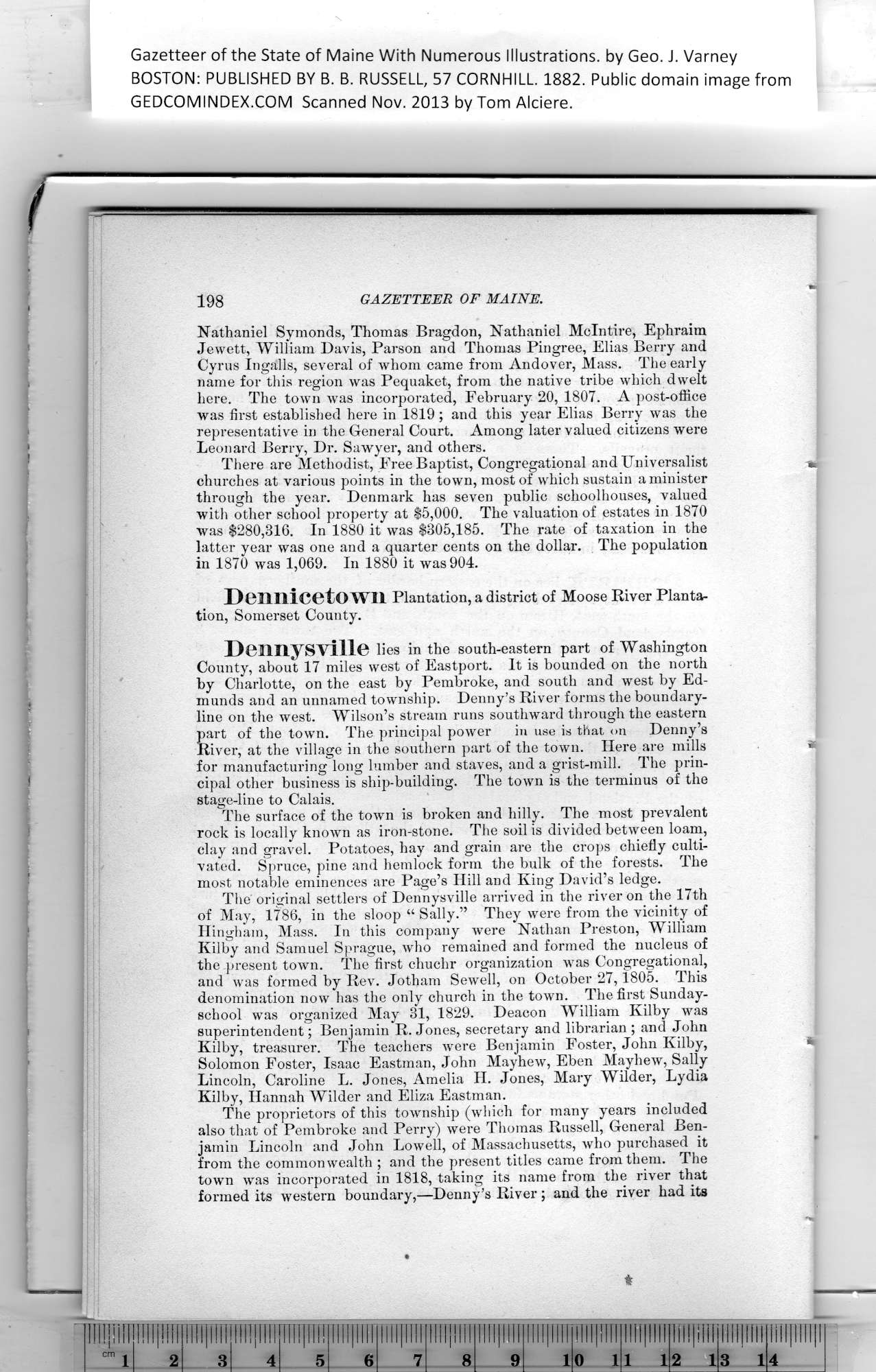|
Gazetteer of the State of Maine With Numerous Illustrations, by Geo. J. Varney
BOSTON: PUBLISHED BY B. B. RUSSELL, 57 CORNHILL. 1882. Public domain image from
198 GAZETTEER OF MAINE.
Nathaniel Symonds, Thomas Bragdon, Nathaniel Mclntire, Ephraim
Jewett, William Davis, Parson and Thomas Pingree, Elias Berry and
Cyrus Iugalls, several of whom came from Andover, Mass. The early
name for this region was Pequaket, from the native tribe which dwelt
here. The town was incorporated, February 20, 1807. A post-office
was first established here in 1819; and this year Elias Berry was the
representative in the General Court. Among later valued citizens were
Leonard Berry, Dr. Sawyer, and others.
There are Methodist, Free Baptist, Congregational and Universalist
churches at various points in the town, most of which sustain a minister
through the year. Denmark has seven public schoolhouses, valued
with other school property at $5,000. The valuation of estates in 1870
was $280,316. In 1880 it was $305,185. The rate of taxation in the
latter year was one and a quarter cents on the dollar. The population
in 1870 was 1,069. In 1880 it was 904.
Dennicetowil Plantation, a district of Moose River Planta-
tion, Somerset County.
Dennysville lies in the south-eastern part of Washington
County, about 17 miles west of Eastport. It is bounded on the north
hy Charlotte, on the east by Pembroke, and south and west by Ed-
munds and an unnamed township. Denny’s River forms the boundary-
line on the west. Wilson’s stream runs southward through the eastern
part of the town. The principal power in use is that on Denny’s
River, at the village in the southern part of the town. Here are mills
for manufacturing long lumber and staves, and a grist-mill. The prin-
cipal other business is ship-building. The town is the terminus of the
stage-line to Calais.
The surface of the town is broken and hilly. The most prevalent
rock is locally known as iron-stone. The soil is divided between loam,
clay and gravel. Potatoes, hay and grain are the crops chiefly culti-
vated. Spruce, pine and hemlock form the bulk of the forests. The
most notable eminences are Page’s Hill and King David’s ledge.
The original settlers of Dennysville arrived in the river on the 17th
of May, 1786, in the sloop “ Sally.” They were from the vicinity of
Hingham, Mass. In this company were Nathan Preston, William
Kilby and Samuel Sprague, who remained and formed the nucleus of
the present town. The first chuchr organization was Congregational,
and was formed hy Rev. Jotham Sewell, on October 27,1805. This
denomination now has the only church in the town. The first Sunday-
school was organized May 31, 1829. Deacon William Kilby was
superintendent; Benjamin R. Jones, secretary and librarian ; and John
Kilby, treasurer. The teachers were Benjamin Foster, John Kilby,
Solomon Foster, Isaac Eastman, John Mayhew, Eben Mayhew, Sally
Lincoln, Caroline L. Jones, Amelia H. Jones, Mary Wilder, Lydia
Kilby, Hannah Wilder and Eliza Eastman.
The proprietors of this township (which for many years included
also that of Pembroke and Perry) were Thomas Russell, General Ben-
jamin Lincoln and John Lowell, of Massachusetts, who purchased it
from the commonwealth ; and the present titles came from them. The
town was incorporated in 1818, taking its name from the river that
formed its western boundary,—Denny’s River; and the river had its
PREVIOUS PAGE ... NEXT PAGE
This page was written in HTML using a program written in Python 3.2
|
